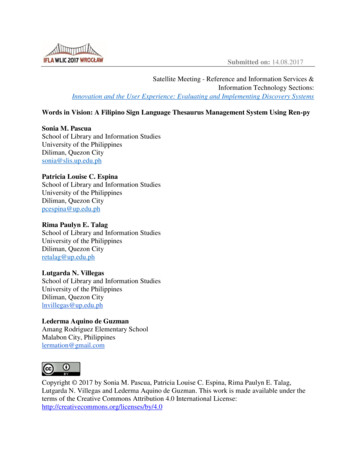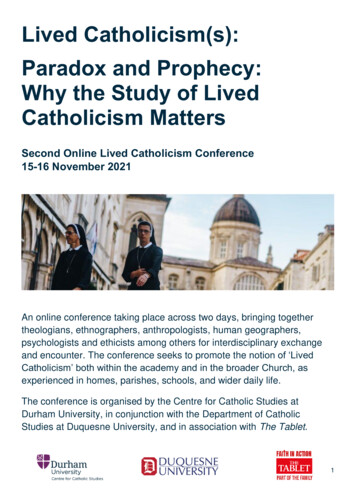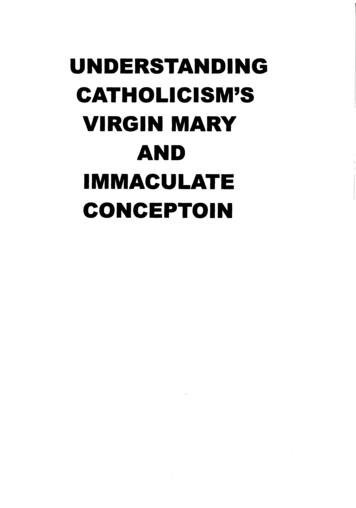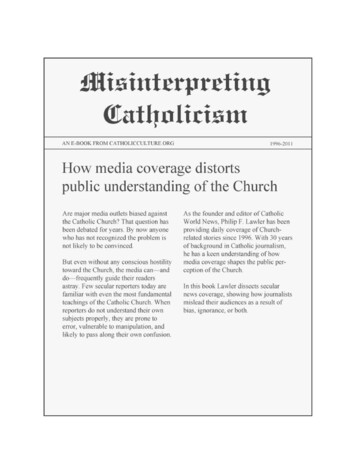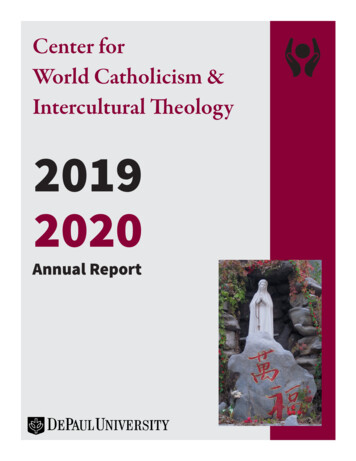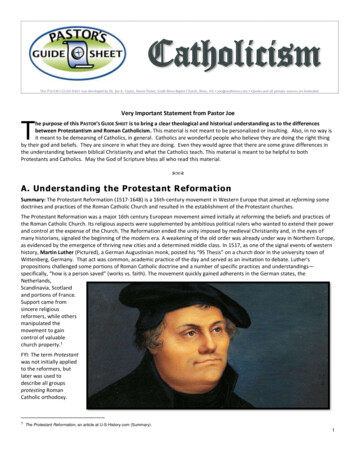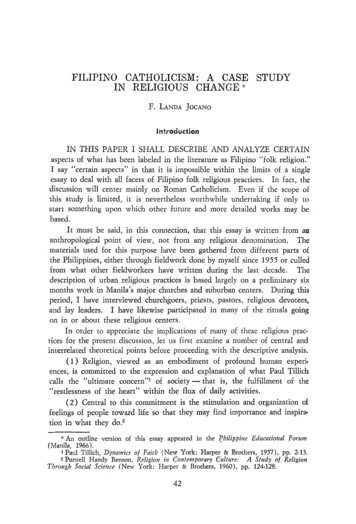
Transcription
FILIPINO CATHOLICISM: A CASE STUDYIN RELIGIOUS CHANGEF.LANDA ]OCANOIN THIS PAPER I SHALL DESCRIBE AND ANALYZE CERTAINaspects of what has been labeled in the literature as Filipino "folk religion."I say "certain aspects" in that it is impossible within the limits of .a singleessay to deal with all facets of Filipino folk religious practices. In fact, thediscussion will center mainly on Roman Catholicism. Even if the scope ofthis study is limited, it is nevertheless worthwhile undertaking if only tostart something upon which other future and more detailed works may bebased.It must be said, in this connection, that this essay is written from ananthropological point of view, not from any religious denomination. Thematerials used for this purpose have been gathered from different parts ofthe Philippines, either through fieldwork done by myself since 1955 or culledfrom what other fieldworkers have written during the last decade. Thedescription of urban religious practices is based largely on a preliminary sixmonths work in Manila's major churches and suburban centers. During thisperiod, I have interviewed churchgoers, priests, pastors, religious devotees,and lay leaders. I have likewise participated in many of the rituals goingon in or about these religious centers.In order to appreciate the implications of many of these religious practices for the present discussion, let us first examine a number of central andinterrelated theoretical points before proceeding with the descriptive analysis.( 1) Religion, viewed as an embodiment of profound human experiences, is committed to the expression and explanation of what Paul Tillichcalls the "ultimate concern"1 of society - that is, the fulfillment of the"restlessness of the heart" within the flux of daily activities.( 2) Central to this commitment is the stimulation and organization offeelings of people toward life so that they may find importance and inspira·tion in what they do. 2*An outline version of this essay appeared in the J!hilippine Educational Forum(Manila, 1966).I Paul Tillich, Dynamics of Faith (New York: Harper & Brothers, 1957), pp. 2-13.2 Purnell Handy Benson, Religion in Contemporary Culture:A Study of ReligionThrough Social Science (New York: Harper & Brothers, 1960), pp. 124-128.42
FILIPINO CATHOLICISM43(3) To achieve this, there should be an awareness of the social andcultural values involved in the process.( 4) These social and cultural values however are learned and acquiredby individuals as they grow up and participate in the affairs of their society.( 5) This learning process involves incorporation into an individual's"self" the perceptual and the ceremonial aspects of religion.( 6) On the perceptual side, religion is often viewed as an affair ofemotions, feelings, aims, and beliefs.( 7) On the ceremonial side, religion involves behavior ranging fromchurch-centered rites to secular (and semi-secular) rituals performed to thedetails of daily activities as influenced by the culture in which the individuallives.( 8) Because of this cultural orientation, whatever is introduced fromthe outside is not readily incorporated into one's religious system but theseelements are first modified to suit one's cultural ways of believing and dcingthings before acceptance is made.( 9) In the event that these elements do not fit into the individual'sexisting pattern of cultural and religious values, they are rejected or if theyare not rejected, they are retained as alternatives but their significance is notemphasized.( 10) If, on the other hand, these new and modified religious valuesare found to be more feasible for social and cultural adjustments, the originalbelief system is either given up or restructured to accommodate the nuancesof the new pattern.( 11) The configuration which results from these shaping and reshap·ing of religious ideas. and practices is what constitutes the framework ofcontemporary Filipino belief system, For lack of precise and better frameof reference I accept the term ''folk religion" to describe this belief system.Having thus briefly stated the thesis of this paper, let us now examinein some details its major bearing on Filipino social and cultural behavior.Historical BackgroundCatholicism was brought to the Philippines by the Spaniards who cameto colonize the islands during the 16th century. The initial contact wasmade in 1521. when Magellan and his crew accidentally hit the island ofHomonhon, held the first mass in Limasawa, and converted Humabon andhis followers in Cebu. However, the new religion did not take roots untilLegaspi arrived in 1565 and took possession of the islands for the SpanishCrown. In order to facilitate the process of conversion and to effect admin·istrative control over the people, a policy of regrouping scattered settlements
44ASIAN STUDIESinto compact villages, known as cabeceras, was adopted. A church was builtat the center of each cabecera.The cabecera system was opposed by many Filipinos even if they conformably built houses in the new villages and flocked to the churches toattend the colorful religious ceremonies associated with the fiesta in honorof the local patron saint, observance of Flores de Mayo, feast of CorpusChristi and so forth. One reason for this resistance was economic: thepeople were subsistence farmers whose fields were located far from thecabeceras and therefore would rather much live near their farms than stayin a far-o village where they could not earn a living.The missionaries realized this difficulty and introduced the cabeceravisita complex as an alternative scheme. Instead of forcing the issue withthe people, they visited the small settlements and in each built a chapelfor religious worship. This was indeed a compromise but apparently aneffective one in spreading the doctrine of Catholicism. Perhaps this is onereason why the new religion was readily accepted by the people. In lateryears, the cabecera became the pobladon, with the church as the focal pointof socio-religious activities and one visita in the barrio with the ermita(chapel) as the center of annual socio-religious ceremonies.Side by side with these developments also emerged two variant formsof Catholicism-the cabecera and the visita. Each of these forms interpretedand emphasized the doctrines and rites of the new faith quite differently.In the cabecera, for example, the pomp and pageantry of Spanish Catholicismwas one way of indoctrinating the Filipinos about the new religion. Otherpious practices include gathering of parishionersevery day at the foot of the wooden cross erected in the main plaza of each village to chant the Rosary, and in many parishes the children walked through thestreets at sunset clJanting the Rosary. (Phelan 1959:73)In the visitas, on the other other hand, such elaborate liturgical symbolismswere seldom emphasized and the people, due mainly to infrequency of. contact with missionaries, were less informed about the doctrines of the newreligion. This lack of doctrinal knowledge gave rise to a different interpretation of Catholic concepts, symbols and rites. EvenThe link between veneration of the saints and idolatry was often crossed, andbelief in miracles sometimes provoked a relapse into magic and superstition (p. 78).Contemporary CatholicismAs it exists today, the cabecera-visita orientations of Catholicism in thecountry has not substantially changed, Much of the practices and conceptshave survived. For purposes of encompassing wider scope in our analysiswe shall use such terms as urban and rural when referring to these variant
FILIPINO CATHOLICISM45forms. Rural Catholicism is one in which Catholic beliefs are attenuated inlocally sanctioned practices, while urban Catholicism is one in which indigenous beliefs are attenuated in Church-allowed, though not sanctioned, rites.Contemporary Orientation ofFunctional CatholicismThese two forms need to be recognized if we are to Understand thedynamics of contemporary Filipino Catholic values and behavior pattern.Much of the difficulty which students of Filipino religious behavior resultsfrom a confusion of these two aspects of Catholicism. This is understandablebecause both variant forms are anchored on the framework of the samecore principles of Catholicism found elsewhere in the western world thateven the people themselves hardly realize that their religion has identifiabledifferences resulting from local interpretations of Christian rites and concepts.Rural CatholicismRaymond Firth, in his book Elements of Social Organization has argued that the "conceptual content and emotional quality of religious beliefsvary accordingly to its function-that is, according to its relation to otherelements in the total system." 3 This is what I have in mind when I saidthat the best way of understanding Catholicism in the Philippines is to viewit in terms of its rural or urban orientations. Catholic concepts in the ruralareas are often articulated with the people's way of life; in urban areas withritual-performance. By this I mean that often the farmers integrate theirreligious precepts with their economic, social, and cultural activities; theurban dwellers often separate their religious beliefs from their occupationaland social commitments. It is the form of worship that matters so muchfor the latter, it is the content which counts for the former.Thus when a Catholic in the barrio is asked what his religion is, hereplies that he is a Roman Catholic. What he means by this is that he wasborn in a Roman Catholic church, and given a Christian name. His parentswere married in the Church and so shall he when he gets married. He goes tochurch occasionally on Sundays, if the poblacion is far, and takes Holy Com·munion once a year during the barrio fiesta. In other words, when an individual says that he is a Roman Catholic in religion he simply means thathe grew up with this orientation. Whether he understands the institutionaland normative organization of the Church is another problem. But this isnot important insofar as he is concerned. For what little he knows of theteachings of the Catholic church normally consists of a body of vague, disconnected ideas and pictures, half-remembered memories of grandmothertales, snatches of conversations overheard in the poblacion, few memorizeds Raymond Firth, Elements of Social Organization (London: Watts & Co., 1951),p. 228.
46ASIAN STUDIESprayers, and gestures observed during the Mass. To him this is what Roman Catholicism is all about. From this standpoint, therefore, many ofwhat an average rural Filipino say about his Catholicism are belied by hisconcrete religious activities. He is more a product of his local culture thanby his Christian religion. His behavior pattern is pegged to the observance of traditional beliefs and practices sanctioned by his community andnot necessarily by his Church.It must be pointed out, in this connection, that uninstructed in Catholicdoctrines as he may be, the rural Filipino is not a mere passive recipient ofreligious ideas. He is also a creative innovator as attested by the way heselects, modifies, and elaborates those elements he draws from the Catholicchurch to reinforce the structure of his culturally defined way of doingthings. Thus in agriculture, for example, we find the use of Christianprayers and ritual objects incorporated with local practices very striking.In Solano, Nueva Vizcaya, for instance, the farmer prays the Apostle'sCreed when he starts planting. Upon reaching the portion of the prayerwhich states ". . .Resurrection of the Body . . ." he plants his field rapidlyso that the crops will grow immediately. In Alimoan, a barrio in Claveria,Cagayan, the farmer goes to the field with a clean attire believing that thiswill influence nature into preventing weeds from growing fast and the prayeris aimed at obtaining God's grace for abundant yield. In Samar and Leyte,Fr. Richard Arens reports that in the town of La Paz (Central Leyte) theplanter "squats in one of the squares of the lot (he is planting) and praysto God to give him a good and fruitful harvest."4 In Iloilo the farmersuse the cross and dried palm-leaves (locally known as ramus) which hadbeen blessed by the priest Juring Lent as part of the pre-planting ritualparaphernalia. Here is a case how pre-planting ritual is formed.Before the farmer brings his basket of seeds to the field, he eats a full break·fast. Eating breakfast is not ordinarily done because two meals a day is thestandard way of living. However, che farmer has to eat otherwise his crops willnot yield abundantly. After eating he ties a piece of cloth around his head, carries the basket on his right shoulder, and proceeds to the field. On reachingthere the farmer places the basket at the right hand corner of the paddy andplants his knotted ( talahib) stalks in the ground. Then he leaves the field andtakes a bath in a nearby well or brook.Naked from the waist up, he returns to the field and waits until the sun isabout right for the high tide. As soon as this time comes he goes to the placewhere the ritual paraphernalia are placed and, holding the rim of the basket withboth hands, murmurs his prayers which consist of one Our Father and two HailMarys. He picks up the cross, puts it aside, and takes a handful of grains from4 Richard Arens, S.V.D., "Animism in tl1e Rice Ritual of Leyte and Samar " Philip.pine Sociological Review, Vol. IV (January 1956), pp. 2-6.'
FILIPINO CATHOLICISM47the basket and broadcasts it in three throwings. He repeats this·. process seventimes before he allows any helper to assist him in doing the job.sDuring harvest, the same religious paraphernalia are used. However,the order of ritual-performance and prayer procedure differs considerably.Here is a case I have noted during a fieldwork in Panay in 1958.Harvesting begins when the heads of rice are uniformly ripe. ·However, beforethis is done another ritual is performed. The farmer returns to his field veryearly in the morning and secures talahib stalks along the way. He knots theseinto one bundle and plants it in the middle of the rice field. On top of this knot,he ties a knotted piece of red cloth containing seven slices of ginger and sevenslices of kalawag, a kind of herbaceous plant with yellow tubers. Then facingthe east, he shouts:"Haw-I am placing this marker here as a sign that if anyone trespassesthis taboo and dies, I have no responsibility."Having done this the farmer goes home in silence, retracing his steps andavoiding people. Reaching the house, he picks up his bamboo basket and returns.In the field he cuts seven stalks of the ripening rice, places them beside the basket,bites his harvesting knife, picks up the rice stalks again, and ties them into onebundle.As he does this he prays Our Father in the reverse order, that is, from theend to the beginning of the prayer. This places magic over the entire crop andand prevents evil spirits from stealing the rice grain. As soon as the ritual basketis full the farmer leaves the field. It is now safe to begin harvesting the crop.The ability to establish a relationship with God acquires added andfavorable dimensions if prayers are first addressed to intermediaries thandirectly to the Almighty. This implies a belief that God is too removedfrom worldly affairs to take any specific interest in men but saints ;tre"almost human," they are close to the world. To God "only saints" canspeak better. A person may pray to the Almighty directly but his chancesof getting what he wants are slim. Thus saints are called upon or askedto intercede for the people with the Higher Divinity for the recovery oflost things, good health, safe voyage, good harvest, long life, and so on.There are images of different saints in almost all Catholic houses in the ruralareas. Most of these imagell are made of wood. This preference for woodis borne by the belief that, according to old folks in Panay, Central Philippines, wooden saints can hear better than those made of stone, marble, orplaster of Paris. The images, it must be remembered, can only have powerto intercede for the people with God after these have been blessed withHoly Water by the parish priest.5 Iri order to avoid cumbersome footnoting, all unacknowledged case studies havebeen derived from my fieldnotes.
48ASIAN STUDIESSaints, in many rural areas, are conceived by the farmers not as Churchpersonalities who have been canonized because of their good work and virtuous living but as supernatural beings with powers similar to those of environmental spirits or the engkantu. As supernatural beings, they can bemanipulated for personal and group ends. Coercion of saints into givingthe devotees what they want are expressed in long novenas, said in churchor at home, for a specified number of days, and in elaborate festivals. Onesuch festival with agricultural overtones is the celebration of San Isidro deLabrador in Nueva Ecija; Pulilan, Bulacan; Angono, Rizal; Naic, Cavite;Biiian, Laguna; and in other towns. This event takes place on May 15, thetraditional date for the beginning of the. rainy season. The main featureof the celebration consists of praying and parade of garland-studded carabaosof farmers. Here is a case rec0rded in Pulilan, Bulacan, in 1957.The colorful event officially started at five o'clock in the afternoon. Theparade known as "paseo ng kalabaw" started from Lumbak, a barrio in the outskirts of Pulilan. About a thousand carabaos, which came from all over the province, participated in the parade. The carabaos covered a total of six kilometers-a march which ended at the church plaza before the shrine of the farmers'saint. This is in order that they may be blessed by the parish priest in 'the beliefthat this will save them from illness and that they will grow stronger. This tradition in Pulilan, according to the old folks was started in 1910 by the town mayor inhonor of San Isidro Labrador. Regarding San Isidro, there are many legendsabout him. He was a farmer who worked in a hacienda in Spain during the 14thcentury. He used to wake up early in the morning to attend mass before beginning his work. It is said that San Isidro performed several miracles during hislifetime.Not only in agriculture are Catholic concepts used but these are alsoutilized by fishermen for similar economic gains. The river festivals inLuzon are gcod examples fur situations in which Catholic beliefs are attenuated in terms of local practices. In Bacoor, Cavite, the ''Caracol'' festivalis celebrated during the month of May. This is in honor of the town'spatron saint, San Miguel. ·The image of the saint is taken on a festival procession, followed by singbg and dancing men and women who ask the saintto give them abundant catch. Bacoor is a fishing community. In Angono,Rizal, San Vicente is believed to be the most powerful patron saint for fishermen. In December each year the people celebrate a feast in honor of thissaint. The following event was noted by a journalist in 1956.The feast day was ushered by the local band which aroused the people up.Before the sun had risen high over the foothills nearby, the people were alreadymassed on the shore where the empty temple (known locally as pagoda) waited.As the images of San Vicente and the Virgin were placed under its canopy, ashout heaved from the crowd and the pagoda was launched. Now, from all directions, motor boats and bancas headed for the massive structure and clustered
FILIPINO CATHOLICISM49around it like ducklings as it wended its way through fields of water lily to theopen sea.From the pagoda itself, a band played continuously. Women prayed and fishermen scrambled up to its platform only to be tossed playfully back to the water.Almost all of the men had their faces painted with rice paste and lipstick. Tothem, the women in the bancas extended bread and wine. The pagoda had afixed course which would have taken but an hour to negotiate but with the merrymaking and the spiritual levity hampering its speed, it took more than three hoursfor the craft to cover its route.By noon, the fluvial parade was ended; the pagoda was hauled with longropes to the shallow, water-lily decked shore and, from there, the images weretra.1sferred to their ornately decorated carriage. All the time, rockets swished upand exploded in the blue burning sky, fishermen group themselves raucously andthree bands tried to outblare each other. From the shore the milling crowd finally ordered itself into a parade which marched back to the town, through thenarrow streets lined with devotees and spectators.Another patron saint worthwhile mentioning in this connection becausefluvial rites associated with him are among the elaborate ones is SanPedro, the fisherman Apostle of Jesus Christ. In June each year in themunicipality of Apalit, Pampanga, the image of this saint is taken downfrom its town's old church and set on a pagoda for a "voyage" up Jnd downthe river. Following its wake, circling about it happily, are bancas mannedby the town's fish-folks. According to informants the watery travel, fromone end of the town to another, dates back during the Spanish time. Thetheory is that it would do the saint good to reexperience his old life upcnthe water, that he will help bring the fish to the corrals and the rivernets.Let us pause for a while and consider this question: Why do farmersand fishermen perform all these rituals and celebrate all those fluvial rites?If someone tells us that these people perform all these rites in otder to havegood harvest and abundant catch, we will perhaps answer: "that does notmake any sense at all." Indeed, to an outsider, these practices do not makesense for there is not much that the farmers and fishermen can do to influence Nature, to make their rice grow vvell or their nets to catch more.But to the rural folks there is more to these practices than merely followil:!g all the steps in the process of planting and fishing: these rites areways of dealing with the supernatural beings and of coping with events.They are aware that Nature has her own laws which govern the destiny ofman. These laws are executed by supernatural beings, in the persons ofsaints and environmental spirits, who prescribe the rigid performance ofrites and the observance of natural phenomena through which they makemanifest their desires. Unless the farmers have the goodwill or favor ofthe saints and other spirits on their side, they will not have good harvests;unless the fishermen perform these yearly festivals, they will not have
50ASIAN STUDIESabundant catch. In ·other words, these religious rites are performed in order to prevent the destruction of crops and the occurrence of bad luck infishing. The introduction of saints, prayers, and other Christian religiousparaphernalia such as the cross, palm leaves, holy water, etc., is one way ofelaborating and making the rituals more pleasing to the supernatural powers,of acquiring more spiritual partners in the pursuit of life goals. To a certainextent the environmental spirits have been replaced by saints and the indigenous prayers by the Christian prayers-but the underlying concepts remain intact in that the imperatives of local beliefs and practices still providethe people with proper ritual contexture of economic propositions in seeking the goodwill and assistance of the supernatural.The close functional association between rituals and personal needs inPhilippine society becomes more apparent if we consider the fact that saintsare appealed to not only for economic reasons but also for good health andcure of illness. In Naga City, for example, the feast of Our Lady of Penafrancia is celebrated with a fluvial parade for good health. It is believedthat whosoever participates in the festivity, provided the individual is deeplyremorseful of his sins, will be healed. This miraculous power of the Virgin-draws devotees from different parts of the country. Nine days before thecelebration, the image of the Virgin is taken from the Church of Penafranciaand is transferred to Naga City cathedral where novenas are said. After the. novena, the Virgin is returned to her permanent shrine near the bank of theriver through the stream in the procession of gaily-decked bancas. OurLady of Penafrancia festival takes place in September.Another popular saint for all occasions is the Sto. Nino. The "historicallegend" surrounding the discovery of this Infant saint in Cebu is so popularthat it is unnecessary to recount it here. The Sto. Nino, nevertheless, is regarded as a rain-god, war protector, sailor's mate, fisherman's guardian,healer, and rice-god. His role as a rain-god however is rather the most popular. In Cebu, this story is told on how the Sto. Nino brings rain.When there was a desperate need for water, and the fields were dry, thepeo; le asked for rain and were instantly given it, so the accounts went. Someother tin:.e3the rain was not prompt in arriving, the natives brought theimage in a procession to the sea and dipped it, often telling the image that if itdid not give them rain immediately, they would leave it there.Normally, the Sto. Nino responded by giving the people rain. Because ofthis belief, the Sto. Nino in Panay, Capiz is always bathed in the river everyyear, amidst feasting and celebrating. The legend on how the Sto. Nifiobrought rain to the drought-stricken town and how the people threatenedthe image with drowning if it did not bring rain is often recounted by theold folks. As it happened, one informant said, "rain came when waterreached the Sto. Nino's neckline."
FILIPINO CATHOLICISM51In Indang, Cavite, the Sto. Nifio is not bathed by dipping- or submerging it in the river as is done in Cebu and Capiz. The bathing normallytakes places in private homes, that is, in thfl homes of the owner of theimage. The following entry is from the 1964 field notes of two NationalMuseum researchers. 6Before the ritual began, leaves o Salay (Cymbopogon cyratus), Kulubo (citrushystrix), and Lukbatz (citrus brandis) were gathered and boiled.· The concoctionwhich resulted was left to cool. Then it was mixed with perfume, and placedin a large basin near the Sto. Nifio.Undressing of the Sto. Nino is done according to the following procedure. Thefirst o the ordinary garments to be removed were the abizarene crimson velvetboots. The exposed feet were wiped with a large piece of cotton, dipped in thebathingwhile at the same time the face of the image was wiped byone of the ritual participants. In this particular case four women were observedhelping each other bathe the Sto. Nino.Then the tunic was removed and the wiping of the neck, arms, hands, andback of the image was done. An old piece of cloth was placed over the neck ofthe image as soon as this was wiped, because, according to an informant, the Sto.Nino catches cold. Then the undergarments were removed. One woman tookthe image's wig. Every portic; n of the exposed body of the image was wipedand immediately covered.While one of the women was wiping the lower limbs of the image, theothers we.te putting on the new white satin tunic. The gold colored vest was placednext, then the gold-colored shoes. The back parts of the vest were sewn together.The sleeves were also sewn to the shoulder-portion of the dress.Then the gold-colored trousers of the Sto. Nino were put on by carefully sewing these tight to the belt, wound around the waist. The last garment to begolden cape. As this was being fixed by one of the participants,placed wasthe others prepared the pedestal, the globe, and the scepter. A new wig wasplaced on the head of the image and then his gold crown. Having thus dressed it,the participants placed it on top of the pedestal and gave it its scepter and globe.Two unlighted candles were placed in front of the Sto. Nifio. The bathingconcoction was removed from the basin md was placed in bottles. When onlyabout a finger deep was left in the basin, the two candles were lighted. Then theoldest member of the family who owns the image led the people in prayer. It isinteresting to note that only 1/3 of the Holy Rosary sequence is said-the restbeing reserved for the evening novena which followed.Mter the prayer, the bottles containing the bathing concoction were given toas medicine. It is believed by the people that the water has curativethepowers.At about five o'clock in the afternoon of the following day, the image wastaken to the Church for blessing. It was not taken from the Church, except during processions, until January 6 when it was returned to the owner's house.6 Jesus Peralta and Avelino Legaspi.(National Museum, Manila).Unpublished Notes on Sto. Nino in Cavite
52ASIAN STUDIESIn Kalibo, Aklan, the festival connected with Sto. Nifio has becomevery elaborate as to attract the attention of tourists. In fact, it has moresodal than religious overtones. The legend behind the ati-atihan recountsthe prowess of the Sto. Nino as the protector of the people. Accordingto the legend, the Muslim pirates landed at the mouth of Aldan Riverone day. While they were heading for the village of Kalibo (then asmall coastal settlement), the men of the village came out to fight the invadir)g enemy. However they were overpowered. Although bloody andfull of mud, they fought savagely. Just about the time when the enemy wasto make a deadly assault on the remaining exhausted fighters, a small boy appeared in the battle scene and drove the pirates away. Then he disappeared.Overjoyed, the people went back to the village, dancing and making noise.Many attested that the boy was the Sto. Nifio who came to help the people.Since then the mud-painted dancers celebrate the ati-atihan festival in honorof the Sto. Nifio.What has the Catholic church to say about the ati-atihan? Accordingto the parish priest, "the Church tolerates the ritual since no one can prevent the people from celebrating the ati-atihan. But this does not meanthat the Church has sanction
that the best way of understanding Catholicism in the Philippines is to view it in terms of its rural or urban orientations. Catholic concepts in the rural areas are often articulated with the people's way of



